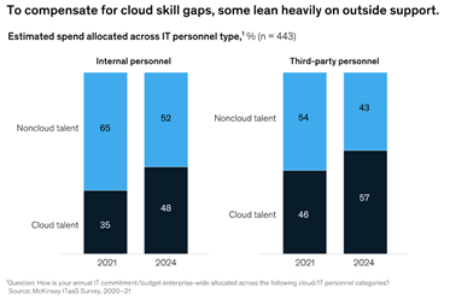Capturing Value in the Cloud

Within the next three years, public-cloud spending on vertical applications is expected to increase by more than 40% each year.
Over the next three years, most companies will hope to have 80% of budgets for IT hosting go toward the cloud. This includes private cloud, infrastructure as a service, platform as a service, and software as a service. Reaching that goal will require a massive effort from both businesses and technology providers.
One of the factors driving this goal is the pandemic, as it triggered a need to speed up the rate of enterprise digitization. However, a larger factor is the fact that cloud adoption can unlock a trillion dollars in business value. Some organizations, though, have leaked a share of that value instead of taking it all, due to inefficiencies in organizing cloud migrations which account for the unexpected cost and delays. It is estimated that about $100 billion of wasted migration will occur over the next three years, and many businesses indicate that the costs around migration are a major inhibitor to adopting the cloud. However, not every organization is experiencing this difficulty. This article will show what aspirations and hurdles business leaders are facing in their journey to the cloud, as well as what successful companies are doing correctly.
Two years ago, legacy infrastructure accounted for most of the budget for IT hosting. Back then, companies set a goal of about 45% of budgets for IT hosting to go toward the cloud by 2021, but because of the pandemic, most leaders made their companies increase that allotment to the 80% stated earlier. Looking forward, they are optimistic of meeting that 80% goal, and data suggest that the goal will indeed be met by 2024.

Hosting applications on the cloud for specific aspects of an industry has growing appeal for all kinds of businesses. Within the next three years, public-cloud spending on vertical applications is expected to increase by more than 40% each year. This is compared to about 25% for horizontal workloads. In manufacturing and healthcare industries, companies are planning on spending even more, some even planning to spend twice as much on vertical applications than on horizontal ones. The benefits for cloud-based vertical applications can be great. One apparel retailer switched to vertical applications and the company was able to avoid custom development, which saved money, time, and complexity. The company increased its international revenues by more than 30% the next year.

Although companies are moving more of their workloads to the public cloud, coordination mistakes in the migration are causing problems. Those inefficiencies can cost a company around 14% more in spending than was planned, and that also adds up to delays in the migration itself. If one extrapolates that globally, that translates to over $100 billion in money wasted in the three-year period. If nothing is done to curb that trend, the costs of moving workloads to the cloud could reduce shareholder value by more than $500 billion.


On average, companies staff around 35% of its cloud needs internally. However, in order to meet the loftier goals, most of those companies will need to bring that percentage up to about 50% by 2024. As such, companies will be looking to hire or reskill over one million new cloud developers globally, which will likely exacerbate tight talent supplies. In order to fill that void, companies can use external labor, but structuring that partnership isn’t always done efficiently.

While most companies struggle with delays in implementation, there are several that succeed in migrating over 60% of their IT-hosting budget to the cloud. Furthermore, they did so within the time frame they set for themselves. Those outperforming companies are 32% more likely to have active CEO sponsors, and they are 57% more likely to hire for advanced skill sets. Just as importantly, they are more decisive in stopping data-center funding in order to shift to cloud migration, even if it means paying fees for early termination.

Companies can put their cloud migrations on a stronger foundation if they follow the example of outperformers. However, providers and partners have to do their part also. Instead of consumption, cloud-service providers should make value creation a core metric, and partners need to adjust the things that make them successful, since the approaches used for on-site implementations are not making their way effectively to the cloud.
About the Authors

Dr. Harry Moore MBE is the Head of Europe, Global Head of Turnaround and Transformation. His experience and expertise include international strategy, corporate turnaround, transformation, market penetration, and increasing profitability. Prior experiences include leading business transformation teams at both KPMG and PwC, and being sponsored by the UK Government to manage initiatives that he designed to secure the future of enterprises in the SME sector in the UK. His strategies resulted in saving roughly 135 UK businesses.

Mr. Mansourian has a 12-year track record as both a management consultant and investment banker, advising clients on valuation, capital markets, structured financing, mergers, acquisitions and divestitures and general corporate strategy. Mr. Mansourian served as Vice President while at NMS Capital Advisors, when the company achieved cumulative sales growth of over 5,100% with annual compounded sales growth in excess of 120% from 2012 to 2017. With over $5 billion in completed transactions, the investment bank consistently ranked among the Top 10 investment banks by the Los Angeles Business Journal. Mr. Mansourian holds an MBA from USC’s Marshall School of Business and a Bachelor’s Degree from UCLA, and the CIPP/US certificate from IAPP.



